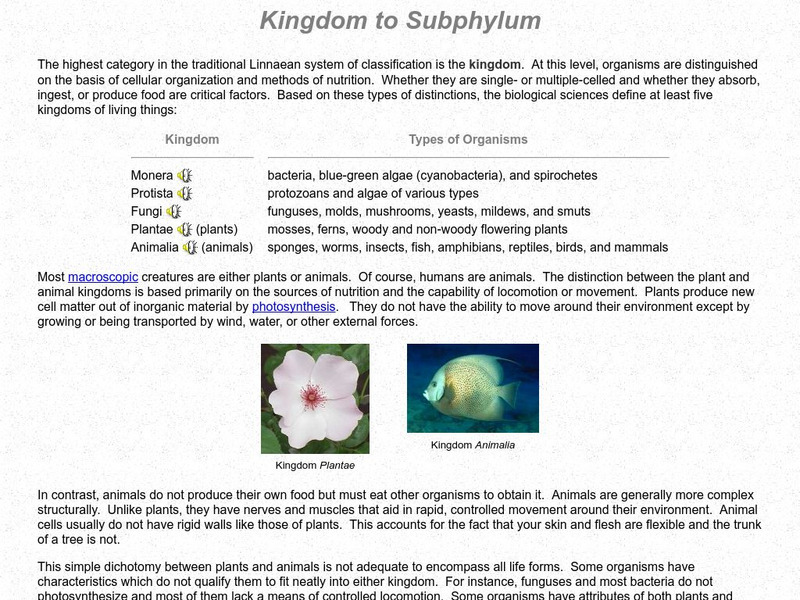Scholastic
Study Jams! Arthropods
No need to be crabby! Here is a resource that teaches your class about the characteristics of arthropods and provides stunning photos of several of them. In addition to the superb slides and their informative accompanying captions, the...
Curated OER
Invertebrate Diversity
Comparative anatomy prevails in the lesson exploring diversity among invertebrates. Biologists examine physical characteristics of an earthworm from phylum annelida and a meal worm from phylum insecta. They also inspect a cricket and a...
Curated OER
Microfishing
Students use a simple method to collect living microorganisms from natural and/or artificial environments and develop skills in microscopy, observation, drawing, speculation, hypothesizing, oral presentation, and raising questions.
Curated OER
Aquatic Invertebrates
Learners examine the impact that human development has on streams. In this stream sampling lesson students compare macroinvertebrate data and graph it.
Curated OER
Life in a Forest Stream
Students assess macro-invertebrates from a stream. In this science lesson plan, students observe, classify and identify organisms found in a stream. A lab station is constructed at the stream sight and students study the different...
Curated OER
Life Cycle: Diversity in a Balance
In this life cycle workbook, 3rd graders complete several different activities in which they analyze different invertebrates, identify arthropods, examine human biology and plants, and study natural environments. 20 different activities...
Curated OER
Animals, Soil, Trees
Fourth graders describe the various kinds of soils and how plants and animals are affected by them. They describe the baic needs of plants, scoring at least a 3 or 4 on a 4-point rubic. Students are able to predict and/or infer what...
Curated OER
Through the Eyes of an Owl
Students describe vertebrates in terms of observable body parts and characteristics and describe life cycles of familiar organisms. They identify familiar organisms as part of a food chain or food web and describe their feeding...
Curated OER
Hunting Invertebrate Fossils in the Classroom
Students acquire a general knowledge of fossils and paleontology, the study of evidence of life in the past and identify the major invertebrate groups (phyla) commonly found in the fossil record.
Curated OER
Invertebrate Classification Challenge
Sixth graders practice invertebrate classification using the organisms that are discussed in their textbooks. In this classification lesson students work in teams to classify organisms.
Curated OER
Internet Invertebrates Scavenger Hunt
In this invertebrates scavenger hunt learning exercise, students research on the Internet 10 various types of invertebrates. They read each question first to determine what they need to look for on the Internet. Then, students respond to...
Curated OER
Invertebrate Study
Young scholars study invertebrates, more specifically flatworms, in this technology-based lesson which features www.nettrekker.com and word processing skills. The lesson concludes with each student create an individual word file of...
Curated OER
Invertebrates and Vertebrate Evolution
Students explore the major characteristics of the major animal phyla. They describe adaptive features that have contributed to the success of animals on land. Students explain how primate evolution provides a context for understanding...
Curated OER
Fish Parasite Survey
Students survey and dissect as many fish as possible. They count nematodes, cestodes and crustaceans on the fish, fill out autopsy reports, and transfer data to a chalkboard data table. Students graph the results of the entire class...
Curated OER
Invertebrate Research Project
High schoolers keep a scientific research notebook on an invertebrate detailing its behavior and responses.
Curated OER
Nervous System
In this nervous system worksheet, students identify and locate each of the vocabulary terms related to the nervous system in the word search. There are 15 biology terms to locate in the puzzle.
Curated OER
Jellyfish
For this science worksheet, students inspect a realistic detailed drawing of a jellyfish. Students read the informative paragraph about jellyfish and color the picture.
Curated OER
Comparative Embryological Study of
Young scholars complete two labs. They observe the fertilization and development of sea urchin and zebrafish embryos. They examine the similarities and differences in the development of an invertebrate vs. a vertebrate animal.
Curated OER
The Water in Our Lives: Be the Bug
Pupils examine a local water supply and create a fictional invertebrate specifically adapted to thrive in that environment. They write a short story from the invertebrate's point of view.
Curated OER
Diversity of Life
Students explore the diversity of life forms and the role that interdependency plays in our world through a mult-segmented unit. This segment introduces the unit.
Yale University
Yale Peabody Museum
This home page describes what the museum has to offer. Links to the exhibits and more information is provided at the bottom of the site.
Palomar Community College District
Palomar College: Kingdom to Subphylum
The highest category of taxonomic classification is the kingdom. This website from Palomar College presents the five kingdoms in an easy-to-read chart and discusses the Animalia and Plantae kingdoms in depth. After reading through the...
PBS
Pbs: The Shape of Life
Companion site for the 8-part PBS series, "The Shape of Life." Each section focuses on a different phylum, from porifera through chordata. This site is highly informative, with beautiful photography.
Smithsonian Institution
Smithsonian National Zoo: Zoogoer Magazine: The Marvelous Majority
This article examines a range of invertebrates. Among the invertebrates discussed included are jellyfish, coral, termites, gypsy moths, octopus, crayfish, and more.

























